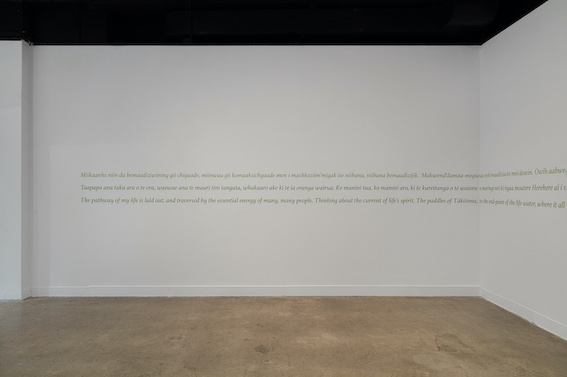“Indigenous knowledge central to Aotearoa”: artist Shannon Te Ao discusses new video work in Canada
Despite experiencing setbacks caused by COVID-19, Wellington-based artist Shannon Te Ao is having a busy year, presenting new video work in two Canadian locations during 2020, and marking his first solo museum exhibitions in the country.
Earlier this year, Te Ao exhibited Ka mua, ka muri, his new video work, at Oakville Galleries in Ontario (with New Zealand curator Frances Loeffler), and after several months of delay, is currently showing the two-channel video and sound installation at Remai Modern in Saskatoon.
Known for his moving image installations that explore time, language, history, land and relations, Te Ao continues to draw inspiration from a range of existing literary material for Ka mua, ka muri, including from Māori whakataukī (proverb) and waiata (song), in order to examine Māori oral tradition and the function of language and translations.
“I’m actively trying to access a mode of storytelling that reflects an understanding that is temporal, experiential and spatialized”, Te Ao tells Toronto-based curator, writer, and researcher Maya Wilson-Sanchez, in a new publication commissioned by online art platform Contemporary HUM.
“Ka mua, ka muri means: We walk backwards into the future. The filmic works, their installation and the integration of textual material (within the installation) all play into this. The understanding that we exist upon a continuum of past/present/future that is as much a living entity as we are is key.”
As well as presenting a two-channel film (in which two sisters sit in a moving vehicle delivering two separate verses immediately after an unnamed tragic event), Te Ao has also developed a text installation featuring several translated versions of his poem Taapapa, demonstrating how the process of translation can invite shared authorship and a multiplicity of voices. Wilson-Sanchez speaks more to this idea in her part-essay, part-dialogue with the artist:
“I enjoyed hearing Te Ao say that his work is more about transportation rather than translation. The meaning of something is transported from one world to another when it is translated, and it changes its shape and colour in order to survive in a new context. This is why Te Ao is interested in how different languages stretch or portray the Māori image of the poem.”
As well as musing on the art of translation, Wilson-Sanchez uses Te Ao’s exhibition to propose language is crucial in maintaining links to indigenous knowledge systems, culture and identity, and discusses the present-day relationship between indigenous populations in colonised nations (including Canada and New Zealand).
To read more comments from both the artist and Wilson-Sanchez on Ka mua, ka muri, visit Contemporary HUM.
Ka mua, ka muri opened to the public at Remai Modern on August 6 and runs until 3rd January 2021. The work is also scheduled to be featured in the upcoming Gwangju Biennale in South Korea and at the Kino Der Kunst Festival in Munich, Germany.

Image credits:
In Text: Installation view, Shannon Te Ao, ‘Ka mua, ka muri’, Remai Modern, Saskatoon, 2020. Photo: Blaine Campbell
Top Photo: Shannon Te Ao, The pathway of my life is laid out, and traversed by the essential energy of many, many people (installation view), 2020, painted text. Image courtesy of Oakville Galleries. Photo: Laura Findlay.















